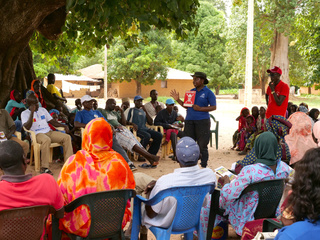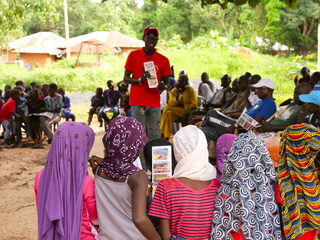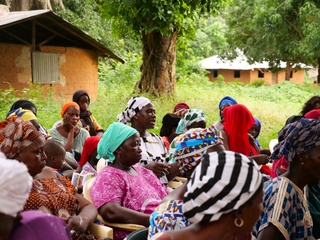share

Martine, after a risk education session in a village near Ziguinchor. | © A. Stachurski / HI
Martine comes from Kouring. In 2009, she was injured in a mine explosion. Since then, she has been speaking out to raise awareness of the dangers of explosive devices and prevent further accidents.
Martine, 50, lost her right leg when a mine exploded in her village. Since then, she has been unfailing in her commitment to the Senegalese mine victims' association ISAD-ASVM, which has been one of HI’s partners in Casamance since the late 1990s. She regularly contributes to risk education sessions to raise awareness to the dangers of mines.
 In 2009, Martine was working at Club Méd in Cap Skirring, on the idyllic Casamance coast. At the end of the season, she returned home to Kouring to help her parents with some work on their house. The village was abandoned at the time, as the inhabitants suspected the presence of mines. On the fifth day, her father asked her to help carry wood. Martine had barely made it past the house when there was an explosion and she was hurled to the ground.
In 2009, Martine was working at Club Méd in Cap Skirring, on the idyllic Casamance coast. At the end of the season, she returned home to Kouring to help her parents with some work on their house. The village was abandoned at the time, as the inhabitants suspected the presence of mines. On the fifth day, her father asked her to help carry wood. Martine had barely made it past the house when there was an explosion and she was hurled to the ground.
“I wanted to get up and run, but I couldn’t. I looked at my foot and realised that I’d stepped on a mine. My father was screaming, “I’ve killed my daughter!”
Two soldiers who had seen the accident wanted to come to her aid, but Martine told them to stay away. "I told them not to come any closer, not to take any risks, that I'd come to them. I'd rather be the only one hurt.” But one of them couldn't bear to see her in that state and ran over to help.
Martine was rushed to the regional hospital where her right leg was amputated. Thanks to the support of ISAD-ASVM, which offers comprehensive care and follow-up for direct and indirect victims of mines, she received high-quality medical care and a prosthesis.
Because of her accident, Martine lost her job at Cap Skirring. She was discouraged at first but thanks to the unstinting support of ISAD-ASVM, she regained hope. The association provided her with training in cloth dyeing to help her get back to work and she was able to set up a small shop.
 "After my accident, I thought I'd never work again. But thanks to the help I was given, I now have my shop, I earn money and life goes on. Today, I want for nothing and my children go to school. I'd like to say to the women who are victims of landmines that they should never lose hope."
"After my accident, I thought I'd never work again. But thanks to the help I was given, I now have my shop, I earn money and life goes on. Today, I want for nothing and my children go to school. I'd like to say to the women who are victims of landmines that they should never lose hope."
Today, Martine runs training courses for other women who have survived mine accidents and want to learn how to dye cloth.
Martine's village, Kouring, is where HI is currently carrying out mine clearance operations. Since the project began in July 2023, HI's teams have destroyed 15 explosive devices and cleared 3,407 m² of land. "I heard that people were clearing mines, so I went to find out what was going on". That's how Martine met Elisabeth, a deminer and HI community liaison officer.
 Since her accident, Martine has regularly contributed to mine awareness sessions organised by ISAD-ASVM in the villages of Casamance. HI's community liaison officers, Elisabeth Sambou and Idrissa Manga, also attend. Together, they explain to the villagers the risks posed by explosive devices, how to identify dangerous situations and the correct behaviour to adopt. Martine, for her part, tells her own story – a testimony that she wants others to hear.
Since her accident, Martine has regularly contributed to mine awareness sessions organised by ISAD-ASVM in the villages of Casamance. HI's community liaison officers, Elisabeth Sambou and Idrissa Manga, also attend. Together, they explain to the villagers the risks posed by explosive devices, how to identify dangerous situations and the correct behaviour to adopt. Martine, for her part, tells her own story – a testimony that she wants others to hear.
"I tell my story because it's important for people to be aware. Going into the field to raise awareness is essential. Since we started this work, the number of accidents has gone down: we can see that it's useful."
Senegal estimates the extent of contamination linked to the conflict in Casamance at 1,200,000 m² of land, spread over five departments. In May 2022, HI relaunched its demining operations in Casamance, where the organisation had already cleared more than 900,000 m² of land since 1996. HI's current two projects will clear 800,000 m² of land by 2025, helping to restore security and socio-economic prosperity to communities in the Ziguinchor and Sédhiou regions.








HI is an independent and impartial aid organisation working in situations of poverty and exclusion, conflict and disaster. We work alongside people with disabilities and vulnerable populations, taking action and bearing witness in order to respond to their essential needs, improve their living conditions and promote respect for their dignity and fundamental rights.
HI is an independent and impartial aid organisation working in situations of poverty and exclusion, conflict and disaster. We work alongside people with disabilities and vulnerable populations, taking action and bearing witness in order to respond to their essential needs, improve their living conditions and promote respect for their dignity and fundamental rights.